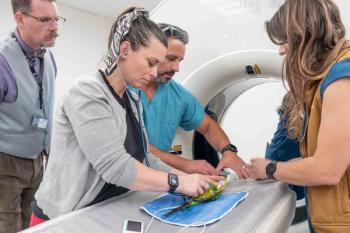
Hepatic ultrasonography: diffuse and focal diseases (Proceedings)
Clipping the hair over the last 2-3 intercostal spaces and extending the area dorsally is important for complete visualization of the liver, particularly in deep chested dog or dogs with small livers.
General considerations
Clipping the hair over the last 2-3 intercostal spaces and extending the area dorsally is important for complete visualization of the liver, particularly in deep chested dog or dogs with small livers. A transducer with a small footprint is recommended for intercostal imaging and subcostal imaging when it is necessary to tilt the probe cranially. Generally a 5-10 MHz transducer is adequate. Scanning in dorsal or lateral recumbency is performed. Gas within the stomach and sometimes colon can hinder imaging, so it is preferable if the patient has been fasted prior to ultrasound. Overall liver size is best assessed on radiographs and is very subjective on ultrasound. Scanning the liver completely in the sagittal and transverse plane is important so lesions are not missed.
Ultrasound of the normal liver and gall bladder
The different lobes of the liver cannot be defined on ultrasound unless peritoneal effusion is present. The left lobe (with lateral and medial divisions) encompasses a third to half of the parenchyma. The caudate lobe extends to the right kidney. The left medial, quadrate, and right medial lobes surround the gall bladder. The location of the divisions of the portal and hepatic veins can sometimes be helpful in determining the affected lobe in the dog.
The liver parenchyma is uniform (course when compared to spleen) in echotexture with interruption by tubular to round anechoic areas that represent the hepatic and portal veins. The portal veins have echogenic walls, while the hepatic veins do not. The echogenicity of the liver is similar to the right renal cortex (liver may be less echoic compared to kidney in the cat) and less echoic compared to the spleen.
The margin of the liver is smooth and the caudoventral margin of the left lobe (seen near the fundus of the stomach) is sharply tapered in the normal animal. Extension of the liver beyond the costal arch is variable (deep chested dogs may not extend to the costal arch where smaller breeds may extend beyond).
Falciform fat, ventral to the liver, is normally of a similar echogenicity to the parenchyma and can sometimes be mistaken for liver. A mirror image artifact, which appears as liver on both sides of the diaphragm, is a common occurrence.
The gall bladder is highly variable in size and contains anechoic fluid with a thin, smooth wall. In dogs it is common to see echogenic material that is gravity dependent (termed "sludge"). Because the gall bladder does not attenuate as much of the ultrasound beam the liver deep to the gall bladder will be increased in echogenicity (distal acoustic enhancement). The intrahepatic biliary system is not seen in normal animals. The common bile duct can be up to 3 mm in diameter in the dog and up to 4 mm in diameter in the cat.
Ultrasound of diffuse liver disease
Diffuse liver disease can cause changes in liver size, contour, echogenicity, and attenuation of the ultrasound beam. Diffuse disease and poorly defined multifocal disease may have some overlap in ultrasound appearance. Multiple disease processes, such as vacuolar hepatopathy and nodular regeneration, may occur simultaneously resulting in both diffuse and multifocal disease.
Below are generalizations of common disease processes and their ultrasound findings:
• Diffuse increase in size with increased echogenicity: Steroid and other vacuolar hepatopathies, lipidosis, lymphoma (more commonly hypoechoic), and mast cell tumor.
• Diffuse increase in size with decreased echogenicity: passive congestion, hepatitis, lymphoma and other round cell neoplasia, amyloidosis
• Diffuse increase in size with mixed echogenicity: combination of disease, hepatitis, lymphoma and other neoplasia, amyloidosis
• Decreased liver size with increased or mixed echogenicity and irregular contour: fibrosis, cirrhosis
• Hepatic lipidosis in the cat generally has a markedly hyperechoic liver when compared to the falciform fat. Aspiration can still be performed to assess for hepatitis or diffuse neoplasia as an underlying cause.
• Vacuolar hepatopathies are common in dogs treated with steroids and dogs with hyperadrenocorticism or diabetes mellitus. In addition to the liver being large and hyperechoic it generally is hyperattenuating, which results in decreased ability to see the deep portions of the liver.
• Inflammatory disease (hepatitis/cholangiohepatitis) has considerable overlap in the categories above, but most commonly acute disease has a decreased liver echogenicity (this results in enhanced visualization of the portal vessels).
• In addition to resulting in a small liver, cirrhosis will cause the liver margin to be irregular and is often seen with concurrent peritoneal effusion.
• Diffuse lymphoma is variable in appearance, but would most commonly cause a diffuse decrease in echogenicity. This finding in combination with characteristic splenic changes and lymphadenopathy make lymphoma highly suspect.
Ultrasound of focal liver disease
Focal mass lesions or asymmetrical hepatomegaly differentials include neoplasia, abscess, granuloma, hematoma, cyst, thrombosis, or lobe torsion. Ultrasound is useful for characterizing solid versus fluid filled lesions (cyst-anechoic; abscess, granuloma, necrotic neoplasia- variable fluid content).
• A small (less than 1.5 cm), solitary, hypoechoic (can vary in echogenicity) nodule may also represent benign hyperplasia.
• Assessment of the relationship of the mass with the hepatic hilus (vessels and common bile duct) is important in cases in which surgery is considered.
• Lymphoma and histiocytic neoplasia can be focal.
• Small cysts (anechoic with distal acoustic enhancement) are generally incidental findings when not associated with masses.
Ultrasound of multifocal liver disease
• Lymphoma and histiocytic neoplasia can be multifocal.
• Target lesions, which are hypoechoic nodules with hyperechoic centers, are most common with metastatic disease.
• Benign disease (nodular hyperplasia) is variable in appearance with either iso, hypo, or hyperechoic nodules.
• In dogs with hepatocutaneous syndrome the liver is enlarged, hyperechoic, with multiple hypoechoic regions giving the appearance of a honey-comb pattern.
Ultrasound abnormalities of the gall bladder
Choleliths will be hyperechoic with distal acoustic shadowing. These are generally incidental findings, although occasionally can cause obstruction or be associated with inflammation. Gall bladder mucoceles have centrally located echogenic material often with a "stellate" or "kiwifruit" pattern (hyperechoic radiating striations). If wall necrosis and rupture has occurred there may be peritoneal effusion and increase in echogenicity of the surrounding fat.
Additional findings
Portal lymph node enlargement can be detected at the liver hilus best seen via the right intercostal window.
Occasionally gas may be present within the biliary system, vessels, or parenchyma. Gas is hyperechoic with reverberation artifact. Mineralization is hyperechoic with a strong distal acoustic shadow. The location of the mineralization may be within the parenchyma or biliary system. Mineralization can be associated with both benign and malignant processes.
Interventional techniques
It is important to remember that liver disease may be present even in the face of a normal ultrasound. If liver disease is suspected aspiration or biopsy may be indicated. Ultrasound guided fine needle aspiration or biopsy of diffuse liver disease and nodules/masses is commonly performed. For the aspirates a 22-gauge, 1 to 1 ½ inch needle is used. Occasionally a longer, spinal needle may be used. Biopsy needles used commonly are 14 to 18-gauge with variable throw length. Aspirates are performed with or without sedation dependent on patient compliance, while biopsy is performed under general anesthesia. Evaluation for hemorrhage should be performed immediately (and if necessary several hours) following the procedure.
Newsletter
From exam room tips to practice management insights, get trusted veterinary news delivered straight to your inbox—subscribe to dvm360.






